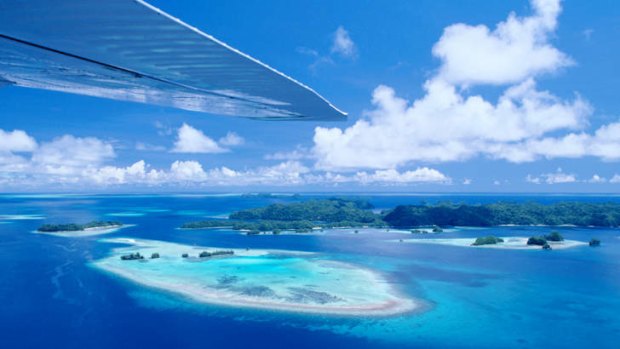
The Rock Islands of Micronesia.Credit: Getty Images
Lance Richardson explores nations rich in culture, charm and conflict as he hops over a key expanse of the Pacific.
The Pacific Ocean is a watery emptiness on the way to California - or at least it seems that way on maps, often represented in stark cerulean monochrome. In truth, the "blue continent", as it's sometimes called, occupies a greater surface area than all of Earth's landmasses combined; and rather than being empty it's crowded with islands, cultures, wrecks, mysteries, lost continents (Zealandia), and grand occult delusions (Lemuria). The Mariana Trench dives deeper than an inverted Everest. The International Dateline divides the Pacific into two days, and a Ring of Fire traces its unsettled edges.
I am somewhere in the middle. Or, more precisely, I am in a strange plane skipping across this eclectic soup, heading from Guam to the island of Chuuk, with its 832-square-kilometre lagoon that offers some of the best diving on the planet. After Chuuk comes Pohnpei, then Kosrae, home to the goddess of breadfruit. The plane then leaves the Federated States of Micronesia en route to Kwajalein and Majuro - both found in the scattershot Marshall Islands. Finally, after more than 14 hours of travel, we land in Honolulu, utterly exhausted.
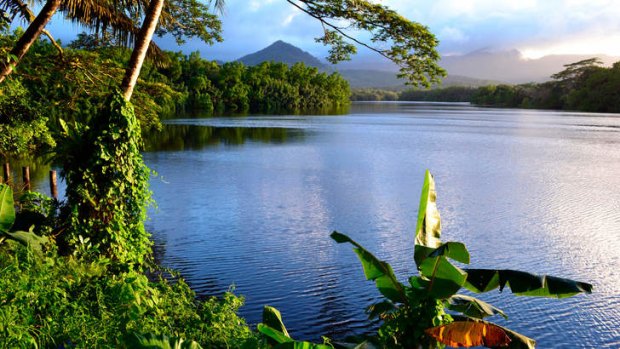
Pacific pursuits: Pohnpei.Credit: Alamy
The "Island Hopper" flight covers 6900 kilometres between Guam and Hawaii. Run by United Airlines, it carries open-water survival gear, a third pilot, extra parts and its own mechanic (just in case).
It lands five times along the way on remote Pacific outposts. In essence, this is a transportation service that is used by missionaries, teachers, surfers, soldiers and deep-sea divers. For anybody living on those islands, it is a lifeline to the outside world.
But for travellers it offers something else. You can use the Island Hopper to bounce to Chuuk with your snorkelling gear, or reach the ruins of Nan Madol on Pohnpei, catching the next Island Hopper when it blows through a few days later. Or you can simply stay on-board the entire way, stretching your legs at each stop (40 minutes), just soaking up the spectacle. At Chuuk and Pohnpei, new passengers climb aboard wearing wreaths of exotic island flowers and when these disintegrate they fill the cabin with fragrant floral debris. Coruscating reefs stretch across the ocean in long sickle curves. Islands look prehistoric, almost uninhabited, and landing on their tiny runways is a nail-biting experience. For an avid traveller looking to celebrate flight and its curious power to reveal the world, the Island Hopper is unsurpassed.
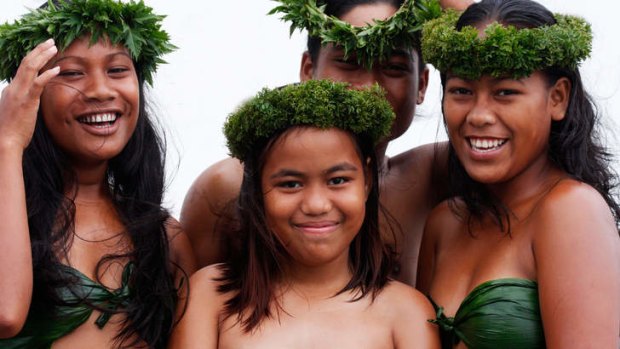
Pohnpei dancers.Credit: Alamy
It occurs to me that at some time between Amelia Earhart and the demise of Pan Am, air travel lost its romance. Popular culture points the finger at the waning sense of style, but what it really lost was more fundamental.
During the early decades of international travel, aviation changed the way we saw the map. It compressed continents, connected far-flung cities, and unfurled oceans for minds that could scarcely comprehend the distances. Flying made the whole globe thrillingly immediate: anything, anywhere, was open to an air passenger of means, from Alice Springs to Zagreb.
And then, like all repetitive motions, awe was superseded by routine, the sky became a freeway, and air travel turned into an elaborate form of carpooling. Whatever happened to those childhood fantasies of lifting off like Superman? We can fly. But how tedious it often turns out to be.
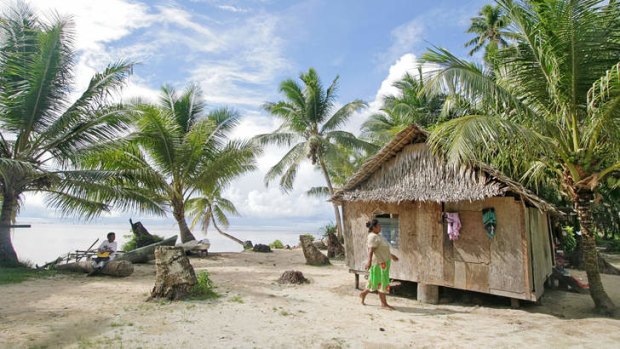
Walung, an isolated village in Kosrae, Micronesia.Credit: Alamy
It was a desire to salvage the mystique of air travel that led me to the Island Hopper.
John McPhee, reflecting on travel in a canoe, called it "an act performed not because it is necessary but because there is value in the act itself." So it is with this plane. I wanted to go on a long and challenging trip that drew attention to its own technical miracle (a tin can shooting through the sky!), in a place I have come to take for granted and need to see afresh. A place such as the Pacific Ocean.
The Island Hopper traces a line that meanders through the rich Pacific story, touching on everything from ancient migratory routes to nuclear testing in the 1950s. The Atomic Energy Commission once called the Marshall Islands "by far the most contaminated place in the world". Ravaged by a 15-megaton bomb in 1954 (courtesy of the United States), Bikini Atoll is not far from Kwajalein, and I find myself searching for terrifying mushroom shapes in the cumulus clouds as we skip past the area.

A sunken WWII Japanese motorcycle.Credit: Corbis
Once we reach Honolulu, Hawaii, I visit two places that unpack the vast Pacific even further. The first is at the Bernice Pauahi Bishop Museum, where a new Pacific Hall will open to the public this month.
When I stop by the museum, a group of Hawaiian artists are working on a giant mural called Moananui, which represents the power and spirit of the Pacific Ocean. "What we're trying to do is evoke the union of the old seas," Meleanna Meyer, the artist overseeing the project, explains. Even in its unfinished state, the artwork is extraordinary, with sinuous blue swirls and a mammoth octopus embracing waves. Moananui will be the centrepiece of a gallery that explores the vibrancy of the Pacific region.
"The concepts, the values, the cultures - they're still alive," Betty Kam, the vice-president for cultural resources at the Bishop Museum, says. The Pacific Hall is filled with themed displays that emphasise diversity and lines of connection. "Most people don't know the relation between the islands," Kam says. She directs me to a stunning wooden floor map that reduces Australia to a blank space and populates the ocean with dozens of careful labels: the Marquesas Islands, the Solomon Islands, the Marianas, Tahiti, Samoa, New Caledonia.
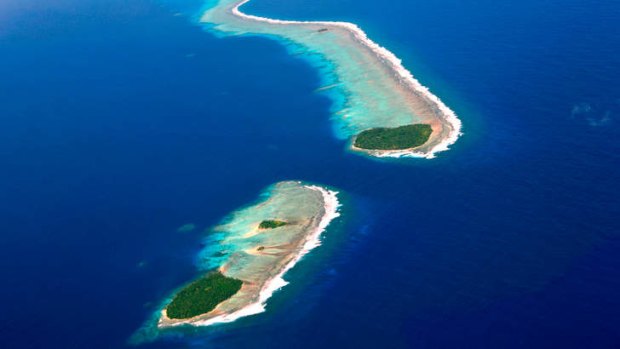
An aerial View of the Chuuk Atoll Islands.Credit: Alamy
"This puts the blue continent right at your hand," she says.
A similar map can be found in the forecourt at Pearl Harbour, now officially known as the World War II Valour in the Pacific National Monument. But here you start to see how complex the ocean truly is, with layers of interpretation and its own brutal chapters of modern warfare. At the seldom-visited but thrilling Pacific Aviation Museum Pearl Harbour, the war of the Pacific is chronicled in careful detail. It is a museum that forces me to reconsider the meaning of the Island Hopper flight.
"Before the war even started, the way the United States got across the Pacific was as Pan Am flew," Ken DeHoff, the executive director of the museum, says. Air travel opened up the ocean and influenced the course of hostilities with the Japanese. Beyond famous battle sites such as Midway and the Coral Sea, "island hopping", or "leapfrogging", took the military to tiny outposts that held important strategic value. These were places to refuel and pause for repairs - places such as the Marshall Islands and Micronesia.
Visiting the Bishop Museum and Pearl Harbour makes my return flight on the Island Hopper a richer experience. Kwajalein in the Marshall Islands remains a US military installation. It was also the setting of a devastating battle that saw 3400 Japanese soldiers killed in 1944. And diving in Chuuk is world-class largely because of Operation Hailstone; where more than 100 Japanese vessels now lie at the bottom of the lagoon, sunk during World War II in what is sometimes referred to as the "Japanese Pearl Harbour."
This tangled layering of culture, conflict and history sees its apotheosis in Guam, where the Island Hopper begins or ends. Flight has shifted my perspective on the wide blue sea. It continues to work its influence here on a daily basis.
Thousands of Japanese people visit Guam for the luxury shopping malls and elaborate beachfront resorts built around Tumon Bay. The US military remains entrenched on the island too. Throughout it all is a rich Chamorro culture that endures like a ribbon of imperishable stone.
One afternoon I go on a drive with Tony Ramirez, a Chamorro historian in his early 60s. We drive south of Tumon Bay, past Ga'an Point and other battle sites from World War II. "We have been involved in a lot of conflicts not of our own making," Ramirez tells me. "How many have I seen on Guam in my lifetime?" He counts them out: the Korean War, the Chinese conflict, Vietnam, the Middle East, North Korea ...
"We're the crossroads of the Pacific because of our location," Ramirez says.
Chamorro people still conduct marlin hunts in the bay, but elsewhere on the island are Texan barbecues, sushi bars, and hula dancing lifted from Hawaii. All of it has washed up on Guam, the crossroads of the Pacific, a weird collection of flotsam that makes it both worldly and utterly original.
Guam, it turns out, is like the blue continent in miniature: stranger, richer, more complicated, and less appreciated than most of those places I'm always travelling away to, staring down at the velvet mystery of the Pacific Ocean from 3000 metres.
The writer travelled courtesy of United Airlines, Hawaii Tourism Oceania and Guam Visitors Bureau.
GETTING THERE
United Airlines has a fare to Guam for about $855 low-season return from Cairns for the twice-weekly flight (4hr 45min); see united.com. From Guam, the Island Hopper runs three times a week towards Honolulu, and three times a week back to Guam. It is possible to get off at an island such as Pohnpei and continue, or retrace your steps. The full Island Hopper trip, with up to two stopovers, starts from $1428 a person return. See united.com.
STAYING THERE
In Guam, most of the hotels are clustered around the beautiful beaches of Tumon Bay. The best choice is the Hilton Guam Resort & Spa, with rooms from $US140 ($157) a night. See guam.hilton.com.
One of Honolulu's newest hotels, the Shoreline Hotel Waikiki, offers rooms from $US219 a night. See shorelinewaikiki.com.
TRIP NOTES
MORE INFORMATION
Sign up for the Traveller Deals newsletter
Get exclusive travel deals delivered straight to your inbox. Sign up now.